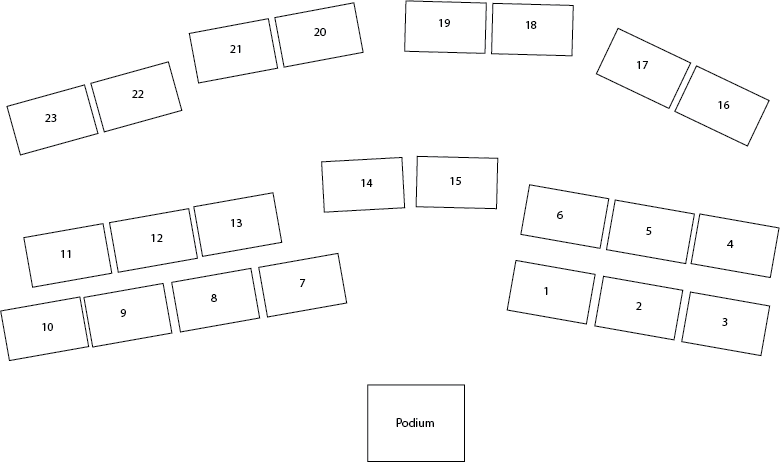Synopsis
This mock Senate activity is a way for students to simulate the legislative process and to better understand the roles of many actors involved in the process. Students will take on the role of Senators, the media, or lobbyists. Senators will need to negotiate to pass or block a bill, while also trying to increase the probability that they are re-elected.
Lesson 1: Mock Senate background
Objective:
SWBAT collaborate to resolve an issue facing the school in order to understand the challenges of legislating.
Materials:
None
Procedures:
Before lesson – Decide upon a school issue that you would like students to address. Suggested issues:
Homework issues – too much is given out or students are not completing it.
The clothing students are wearing are causing a host of issues (bullying, inappropriate dress, etc.)
Students complain they are not getting enough sleep at night.
Summers off cause students to lose a wealth of information and it impedes skill development.
1) Divide students into groups of 3-4. Have students brainstorm ideas about how they would address the chosen issue.
2) Have groups write a proposal (bill) for a new school rule (law) to address their issue.
3) Review what a loophole is. Example: Salvador needs to get to the cafeteria quickly, but there is a school rule against running. Salvador skips to class.
Review how that loophole could be closed – change the rule to “all students must walk.”
4) Have groups review their rule and close and loopholes. Make sure the purpose of the rule is reflected in what is written.
5) Have groups submit their final proposals. Review proposals and choose two that are plausible rules, but conflicting (if the two chosen rules are too similar, the mock Senate won’t have much to debate about).
Lesson 2: Mock Senate introduction
Objective:
SWBAT simulate a mock Senate in order to understand the challenges of legislating and the roles of the various actors involved.
Materials:
Mock Senate schedules
Mock Senate roles
Mock Senate election probability boards
Mock Senate name cards
Mock Senate fundraising quiz
Mock Senate funds distribution form
Procedures:
Before class – Complete the roles for Senator 14, Senator 15, Lobbyist 22, and Lobbyist 23, depending on the issue your class will debate. Set up the class like so, with name cards on the respective desks:

Mock Senate setup
1) Assign students to a number. Make sure the students who were in the groups with the winning rule submissions are numbers 1-4 and 7-10.
2) Introduce the concept of the mock Senate and have students read their roles. Read the roles of the whips aloud.
3) Review the schedule together.
4) Hand out and explain how the election probability boards work.
5) Have each whip meet with his or her party to discuss strategy and who will be introducing their bill tomorrow. Use this time to meet with the independents, media, and lobbyists to clarify their roles with them.
Lesson 3: Mock Senate day 1
Objective:
Simulate a mock Senate in order to understand the challenges of legislating and the roles of the various actors involved.
Materials:
Mock Senate schedule
Mock Senate roles
Mock Senate election probability boards
Mock Senate name cards
Mock Senate fundraising quiz
Mock Senate funds distribution form
Mock Senate funds spreadsheet
Procedures:
1) Give each side a few minutes to discuss strategy and prepare for the bill introductions. Then play day 1 of the mock Senate according to the schedule.
2) At the end of the period, collect funds distribution forms and input results into funds spreadsheet.
Lesson 4: Mock Senate day 2
Objective:
SWBAT simulate a mock Senate in order to understand the challenges of legislating and the roles of the various actors involved.
Materials:
Mock Senate schedules
Mock Senate roles
Mock Senate election probability boards
Mock Senate name cards
Mock Senate funds distribution form
Mock Senate funds spreadsheet
Procedures:
1) Distribute campaign funds from yesterday, including those earned from the fundraising quiz.
2) Determine if Senator 9 is indicted with a coin-flip.
3) Play day 2 of the mock Senate.
4) At the end of the period, collect funds distribution forms and input results into funds spreadsheet.
5) Determine if Senator 3 has said anything controversial that would jeopardize their cabinet nomination. Also, reduce Senator 10’s re-election odds from 50% to 41.7% if they showed any public support for compromise.
6) Collect final rule proposals.
Lesson 5: Mock Senate day 3
Objective:
SWBAT reflect on the challenges Senators face in legislating and the motivations of the various actors involved.
Materials:
Mock Senate schedules
Mock Senate roles
Mock Senate election probability boards
Mock Senate name cards
Mock Senate funds distribution form
Mock Senate funds spreadsheet
Mock Senate reflection
Procedures:
1) Distribute or project the final rule proposals to all Senators.
2) Determine and record the election results using the election probability boards and a random number generator.
3) Allow students to vote. For each bill, students should either vote in favor, opposition, or should abstain. A majority is needed to pass a rule.
4) Have students complete the reflection individually. Have students share answers in groups of 3-4. Try to have at least one media member/lobbyist, and one member of the Pizza and Birthday parties in each group. Discuss reflections as a class.
5) Exit slip: What did you learn about the legislative process from the mock Senate?
